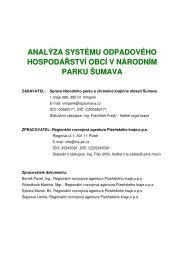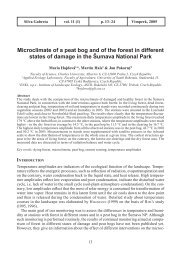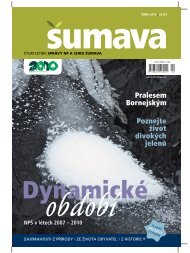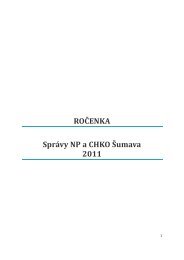Algae, Cyanobacteria and Chytridiales of Černé Lake in the ...
Algae, Cyanobacteria and Chytridiales of Černé Lake in the ...
Algae, Cyanobacteria and Chytridiales of Černé Lake in the ...
Create successful ePaper yourself
Turn your PDF publications into a flip-book with our unique Google optimized e-Paper software.
Chloromonas nivalis). The planktonic alga Raphidonema nivale also should be recognised<br />
as a cryoseston species, s<strong>in</strong>ce it was described from coloured snow on Mt. Pich<strong>in</strong>cha, Equador.<br />
Long-term changes<br />
Written records about life <strong>in</strong> <strong>Černé</strong> <strong>Lake</strong> date back to 1897, <strong>and</strong> core analyses enables us to<br />
evaluate <strong>the</strong> biological history <strong>of</strong> <strong>the</strong> lake from postglacial times. The genus Botryococcus<br />
was <strong>the</strong> dom<strong>in</strong>ant green alga found <strong>in</strong> cores at depths <strong>of</strong> 0.75–1 m, <strong>in</strong>dicat<strong>in</strong>g a high eutrophication,<br />
that resulted from high rates <strong>of</strong> erosion caused by <strong>the</strong> retreat <strong>of</strong> <strong>the</strong> forest <strong>in</strong> this<br />
layer was as also suggested by high content <strong>of</strong> Mg (BŘÍZOVÁ 1996, VESELÝ 1998). Accord<strong>in</strong>g<br />
to JANKOVSKÁ & KOMÁREK (1998), <strong>the</strong> 3 species <strong>of</strong> Botryococcus (B. pila, B. neglectus, <strong>and</strong><br />
B. braunii) were <strong>the</strong> exclusive dom<strong>in</strong>ants dur<strong>in</strong>g <strong>the</strong> whole Holocene period, especially <strong>in</strong><br />
<strong>the</strong> Middle <strong>and</strong> Late Holocene, where B. pila <strong>in</strong>dicate dystrophic conditions <strong>and</strong> B. neglectus<br />
mesotrophic ones. It is <strong>in</strong>terest<strong>in</strong>g that Botryococcus disappeared just recently; while B.<br />
braunii alone was once observed <strong>in</strong> <strong>the</strong> phytoplankton <strong>of</strong> <strong>the</strong> neighbour<strong>in</strong>g Čertovo <strong>Lake</strong><br />
(LUKAVSKÝ, unpubl. data). A similar dom<strong>in</strong>ant role <strong>of</strong> Botryococcus was recorded <strong>in</strong> Slepé<br />
Pleso <strong>Lake</strong> <strong>in</strong> <strong>the</strong> High Tatra Mts., Slovakia (LUKAVSKÝ 1994), however, this lake is only a<br />
small pool on <strong>the</strong> surface <strong>of</strong> a large peat bog.<br />
Long-term trends <strong>in</strong> <strong>the</strong> hydrochemistry <strong>of</strong> acidified lakes have been discussed <strong>in</strong> several<br />
papers (VESELÝ 1996, VRBA et al. 2000). The concentrations <strong>of</strong> <strong>the</strong> pr<strong>in</strong>cipal ions (such as<br />
NO , SO ) were <strong>in</strong>creas<strong>in</strong>g until 1985, <strong>and</strong> <strong>the</strong>n, generally, have been slowly decreas<strong>in</strong>g<br />
3 4<br />
(VRBA et al. 2006). The dramatic decrease <strong>of</strong> SO <strong>in</strong> <strong>the</strong> atmosphere (by ca. 70%) was fol-<br />
2<br />
lowed by a 50% decrease <strong>of</strong> SO <strong>in</strong> wet deposition, <strong>and</strong> a 26–30% decrease <strong>in</strong> <strong>the</strong> water <strong>of</strong><br />
4<br />
<strong>Černé</strong> <strong>Lake</strong> (VESELÝ 1996, KOPÁČEK et al 2002, KOPÁČEK & VRBA 2006). The NO content <strong>in</strong><br />
3<br />
<strong>the</strong> water is also correlated with <strong>the</strong> decrease <strong>of</strong> both NH <strong>and</strong> NO <strong>in</strong> deposition.<br />
4 3<br />
Phosphorus, which is <strong>the</strong> limit<strong>in</strong>g nutrient <strong>in</strong> <strong>Černé</strong> <strong>Lake</strong>, has not been periodically evaluated.<br />
Its concentration is connected with <strong>the</strong> total Al, which is capable <strong>of</strong> immobiliz<strong>in</strong>g P;<br />
so that acidification controls, via Al, <strong>the</strong> productivity <strong>of</strong> algae (also when <strong>the</strong> P load was<br />
stable for ca. 40 years; VRBA et al. 2000, 2006).<br />
The quantity <strong>of</strong> algae <strong>in</strong> <strong>Černé</strong> <strong>Lake</strong> was evaluated for <strong>the</strong> first time by B. Fott (unpublished)<br />
who found, us<strong>in</strong>g centrifuation or an Utermöhl chamber, about 260 cells.ml –1 <strong>in</strong> <strong>the</strong><br />
surface water (August 1936). In August 1992 follow<strong>in</strong>g species were found (AMBROŽOVÁ<br />
1995): Perid<strong>in</strong>ium (FOTT = 68, AMBROŽOVÁ = 165), Monallanthus stichococcoides (60/0),<br />
Chromul<strong>in</strong>a <strong>and</strong> Chrysomonads (35/706), Carteria, Chlamydomonas, <strong>and</strong> green cells (30/0),<br />
Merismopedia (30/0), D<strong>in</strong>obryon protuberans (16/14), Bitrichia (Diceras) ollula (10/706),<br />
Cryptomonas (3/0). Perid<strong>in</strong>ium <strong>and</strong> Chrysophyta <strong>in</strong>creased <strong>in</strong> quantity, while green flagellates<br />
<strong>and</strong> Heterokontae substantially decreased. The total cell number was 1828 cells.ml –1 <strong>in</strong><br />
1992, which is <strong>in</strong> contradiction to <strong>the</strong> trend <strong>in</strong>dicated by Secchi depth (Fig. 21).<br />
The Secchi depth <strong>of</strong> <strong>the</strong> lake has been chang<strong>in</strong>g considerably over time (Fig. 21). A substantial<br />
<strong>in</strong>crease <strong>of</strong> Secchi depth <strong>in</strong> <strong>the</strong> period 1960–1990 can be expla<strong>in</strong>ed by <strong>the</strong> precipitation<br />
<strong>of</strong> humic compounds, caused by Al (KOPÁČEK et al. 2001b, VRBA et al. 2006). Even <strong>the</strong><br />
orig<strong>in</strong> <strong>of</strong> <strong>the</strong> name, <strong>Černé</strong> <strong>Lake</strong>, was <strong>in</strong>spired by <strong>the</strong> dystrophic, blackish water (VRBA et al.<br />
2000). It may be, that this was <strong>the</strong> second acidification period <strong>in</strong> <strong>the</strong> lake’s history, s<strong>in</strong>ce <strong>the</strong><br />
dystrophic Holocene period is <strong>in</strong>dicated by <strong>the</strong> dom<strong>in</strong>ance <strong>of</strong> Botryococcus pila <strong>in</strong> <strong>the</strong> core<br />
(JANKOVSKÁ & KOMÁREK 1998).<br />
The acidification <strong>of</strong> <strong>Černé</strong> <strong>Lake</strong> is still prom<strong>in</strong>ent, but an obvious recovery is <strong>in</strong>dicated,<br />
e.g., by <strong>the</strong> comeback <strong>of</strong> Ceriodaphia quadrangula (VRBA et al. 2003). Acid substrates <strong>in</strong> <strong>the</strong><br />
catchmend, numerous peat bogs with<strong>in</strong> it, <strong>and</strong> norway spruce as <strong>the</strong> dom<strong>in</strong>ant tree <strong>in</strong> <strong>the</strong><br />
surround<strong>in</strong>g forest have all accelerated acidification. Air pollution emissions were, however,<br />
24



![Zima 2008 [4MB] - Národní park Šumava](https://img.yumpu.com/21236024/1/184x260/zima-2008-4mb-narodni-park-sumava.jpg?quality=85)






